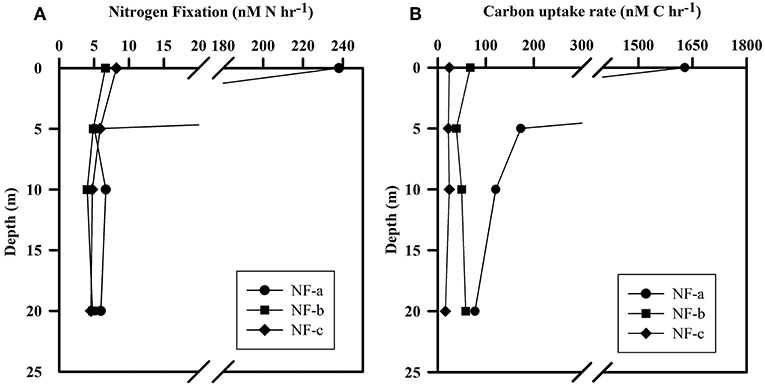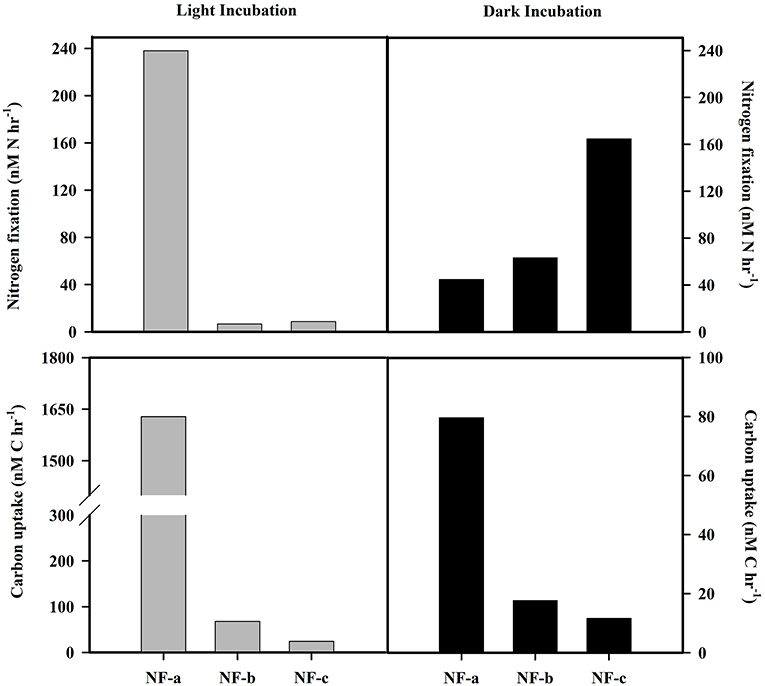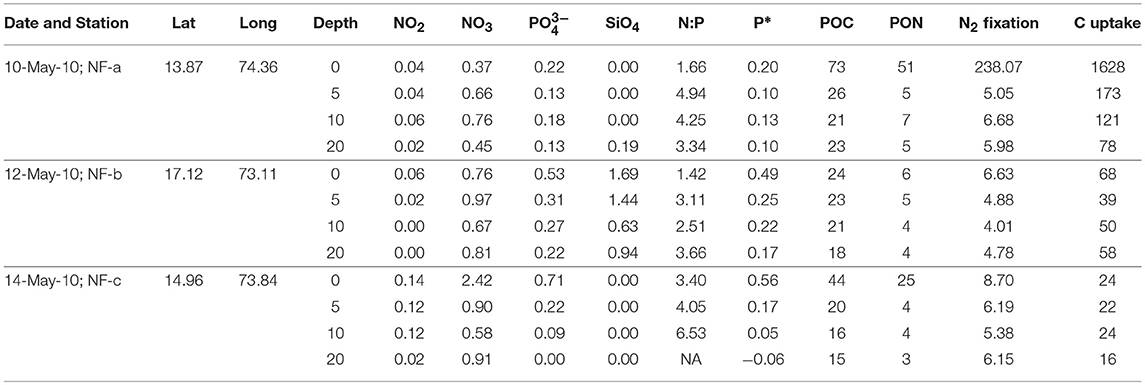N2 Fixation in the Eastern Arabian Sea: Probable Role of Heterotrophic Diazotrophs
- 1Physical Research Laboratory, Geosciences Division, Ahmedabad, India
- 2National Institute of Ocean and Technology, Chennai, India
A corrigendum on
N2 Fixation in the Eastern Arabian Sea: Probable Role of Heterotrophic Diazotrophs
by Kumar, P. K., Singh, A., Ramesh, R., and Nallathambi, T. (2017). Front. Mar. Sci. 4:80. doi: 10.3389/fmars.2017.00080
In the original article, there were errors in the text, Figure 5 and Figure 6, and Tables 1 and 2. We made a mistake in the reporting N2 fixation and carbon uptake rates. While reporting mean N2 fixation and mean carbon uptake rates, we forgot to include the duplicate values in calculation in the original article. We provide correct values in the following sections, figures and tables as described. Corrections have been made to the Results and Discussion section (sub-section “N2 Fixation Rate and Carbon Uptake,” first line of first paragraph and sixteenth line of the first paragraph), the Conclusion (eighth line), as well as Figures 5 and 6 and Tables 1 and 2.

Figure 5. (A) N2 fixation rate and (B) Carbon uptake rate at the sampling location (NF-a, NF-b, and NF-c) for light (at ambient conditions) incubation for samples at different depths.

Figure 6. N2 fixation and carbon uptake rate at surface for light (gray bars) and dark (black bars) incubation.

Table 1. Sampling Date, Latitude (°N), Longitude (°E), water depth (m), Nutrients concentrations (μM), N:P, P* (μM), particulate organic carbon (POC, μM) and nitrogen (PON, μM), N2 fixation (nM N h−1) and carbon (C) uptake (nM C h−1) at the three locations sampled in the eastern Arabian Sea.

Table 2. Summary of Photic N2 fixation rates in the world oceans (Table updated after Singh et al., 2013; Benavides and Voss, 2015). (Only last row in the original Table 2 should be replaced by the following row).
Results and Discussion
In the sub-section “N2 Fixation Rate and Carbon Uptake,” first line of the first paragraph:
N2 fixation rates varied from 4 to 238 nM N h−1, while carbon uptake rate ranged between 16 and 1628 nM C h−1 (Figure 5).
In sixteenth line of the first paragraph:
Heterotrophs contributed up to 52% to the total N2 fixation (estimated from light and dark incubations, assuming light incubations correspond to phototrophic and dark to heterotrophic).
Conclusion
In the eighth line:
Based on the higher N2 fixation values at the surface for dark incubation, we hypothesize that heterotrophic fixers dominantly (about 52% of total N2 fixation is by heterotrophs) play an important role in fixing N2.
In the original article, there were mistakes in Figure 5, Figure 6, Table 1 and Table 2 as published. The figures and tables are now redrawn and reported with the revised N2 fixation and carbon uptake rates. In Table 2, we reported areal rates wrongly in the last row. The corrected Figure 5, Figure 6, Table 1 and Table 2 are presented below.
The authors apologize for this error and state that this does not change the scientific conclusions of the article in any way. The original article has been updated.
References
Benavides, M., and Voss, M. (2015). Five decades of N2 fixation research in the North Atlantic Ocean. Front. Mar. Sci. 2:40. doi: 10.3389/fmars.2015.00040
Keywords: dinitrogen fixation, 15N, 13C, nitrogen budget, carbon uptake rate, nutrients, biogeochemistry, Arabian Sea
Citation: Kumar PK, Singh A, Ramesh R and Nallathambi T (2019) Corrigendum: N2 Fixation in the Eastern Arabian Sea: Probable Role of Heterotrophic Diazotrophs. Front. Mar. Sci. 6:223. doi: 10.3389/fmars.2019.00223
Received: 30 August 2018; Accepted: 10 April 2019;
Published: 26 April 2019.
Edited and reviewed by: Selvaraj Kandasamy, Xiamen University, China
Copyright © 2019 Kumar, Singh, Ramesh and Nallathambi. This is an open-access article distributed under the terms of the Creative Commons Attribution License (CC BY). The use, distribution or reproduction in other forums is permitted, provided the original author(s) and the copyright owner(s) are credited and that the original publication in this journal is cited, in accordance with accepted academic practice. No use, distribution or reproduction is permitted which does not comply with these terms.
*Correspondence: Arvind Singh, YXJ2aW5kc0BwcmwucmVzLmlu
†Present Address: R. Ramesh, School of Earth and Planetary Sciences, NISER, Jatni, India
 P. Kiran Kumar
P. Kiran Kumar Arvind Singh
Arvind Singh R. Ramesh1†
R. Ramesh1†